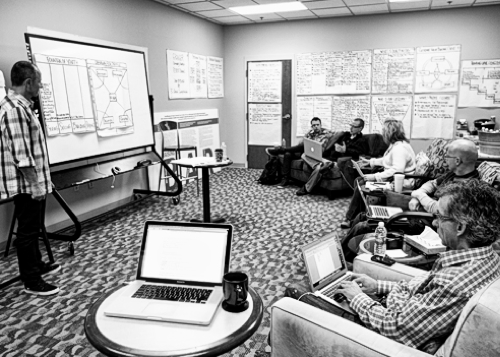Does your lack of organizational focus keeps everyone too busy, especially you?
Do you feel like most days you are running on a ministry treadmill? You know the feeling – it’s when the busyness of ministry creates a progressively irreversible hurriedness in your life as a leader. The sheer immediacy of each next event or ministry demand prevents you from taking the time to look to the future horizon – and sometimes even today’s calendar – until it crashes in on you.
All too often, today’s demands can choke out the needed dialogue for tomorrow. When this occurs, your multiplied activity accomplishes little of value and prevents you from ministry with a clear sense of what God has called you to do.
THE QUICK SUMMARY – Escape Velocity, by Geoffrey Moore
In Escape Velocity, Geoffrey A. Moore, author of the marketing masterwork Crossing the Chasm, teaches twenty-first century enterprises how to overcome the pull of the past and reorient their organizations to meet a new era of competition. The world’s leading high-tech business strategist, Moore connects the dots between bold strategies and effective execution, with an action plan that elucidates the link between senior executives and every other branch of a company.
For anyone aiming for the pinnacle of success, Escape Velocity is an irreplaceable roadmap to the top.
A SIMPLE SOLUTION – Execute Your Vision
While forecasting the future should be seen as a necessary action for ministry today, Auxano Founder and Team Leader Will Mancini believes that for every leader who surfs the waves of cultural change there are a hundred who are stuck in a whirlpool vortex – and they feel they can’t keep their heads above the waters.
The world outside us is not stuck. It is changing rapidly even as we find ourselves sinking deeper and deeper into the comfort of yesterday.
It’s time to go back to the drawing board for vision, strategy, and execution.
The larger and more successful the enterprise, the greater the inertial mass, the harder it is to alter course and speed.
What if there is some hidden force that is working against your best efforts? What if this force is operating inside your own company, with the full support of your executive team, your board, and indeed yourself? What if this force is able to mysteriously redirect resource allocation so that it never quite gets deployed against new agendas? That force is the pull of the past.
To move beyond the pull of the past, you must organize and shape your approach to the planning effort of next year with three goals foremost:
- Articulate a compelling vision of the future that others will want to support.
- Set a strategy consistent with your vision.
- Resource your execution so that it can accomplish your highest aspirations.
To free your organization’s future from the pull of the past, to escape the gravitational field of your prior year’s operating plan, you need to apply a force that is greater than the inertial momentum of current operations.
Newton’s first law of motion states that an object at rest tends to stay at rest and an object in motion tends to continue in the direction in which it is currently moving. The same goes for resource allocation.
When organizations begin their strategic planning effort by circulating last year’s operating plan, they reinforce the inertial properties of the resources as currently allocated. This is not a good outcome, but to be frank, there is no help for it.
What you can do, however, is get yourself and your colleagues out in front of it. Execution is acting and reacting in real time to an ever-changing set of circumstances, all the while maintaining your strategic intent. Execution power, by contrast, is created in advance of the real-time moment of truth and focuses on getting the right resources in the right position for maximum impact and efficiency.
Geoffrey A. Moore, Escape Velocity
A NEXT STEP
It’s time to develop a visionary state of mind by practicing two essentials. First, you need to grasp that clarity isn’t everything, but it changes everything. Too many times, church leaders are making decisions and having conversations without the vantage point of clarity first. Is there anything greater that we should be working on? Why would we put our foot on the gas petal before the fog lifts? All activity is not progress. In churches today, it’s all too easy to be busy without intention or direction.
Second, we need to state our vision framework before we frame our vision statement. Leaders must work from a common template to understand and communicate vision, or everyone will stay confused. The story and vision of the church won’t work its way into staff meetings, volunteer training, membership moments, casual conversations or our prayer lives.
Introducing the Vision Frame
No leader should lead, no team should meet, and no initiative should start without understanding the Vision Frame. In short, the Vision Frame reminds us that there are five irreducible questions of clarity. Your church’s vision isn’t totally clear until your leadership team can answer all five questions in a concise and compelling way:
- MISSION as Missional Mandate: What are we doing?
The missional mandate is a clear and concise statement describing what your church is ultimately supposed to be doing.
- VALUES as Missional Motives: Why are we doing it?
Missional motives are shared convictions that guide the actions and reveal the strengths of your church.
- STRATEGY as Missional Map: How are we doing it?
The missional map is the process or picture that demonstrates how your church will accomplish its mandate on the broadest level.
- MEASURES as Missional Life Marks: When are we successful?
Missional life marks are a set of attributes in an individual’s life that define or reflect the accomplishment of the church’s missional mandate.
- VISIONPROPER as Missional Mountaintop + Milestones: Where is God taking us?
Vision Proper is the living language that anticipates and illustrates God’s better intermediate future.
When you commit to clarity, great things happen. You empower a movement of people to tell the story of what God is doing in and through your church. You can seamlessly share the what, the why, and the how.
Don’t let all the different vision terms and concepts excuse you from being an everyday visionary. It’s time to stop stabbing at the future with a few short phrases. You can guide your church with stunning clarity. Remember Jesus. He walked on Earth with total clarity about His identity, His mission and His destiny. Shouldn’t His body today do the same?
Download a Vision Frame Overview and work through it with your lead team.
Start a conversation with an Auxano Navigator today to learn more about how the Vision Frame can help you execute your vision.
Excerpt taken from SUMS Remix 64-2, released April 2017
This is part of a weekly series posting content from one of the most innovative content sources in the church world: SUMS Remix Book Summaries for church leaders.
SUMS Remix takes a practical problem in the church and looks at it with three solutions; each solution is taken from a different book. Additionally, a practical action step is included with each solution.
As a church leader you get to scan relevant books based on practical tools and solutions to real ministry problems, not just by the cover of the book. Each post will have the edition number which shows the year and what number it is in the overall sequence. (SUMS Remix provides 26 issues per year, delivered every other week to your inbox).
>> Subscribe to SUMS Remix <<

Tags: Church Unique, Execute your vision, Geoffrey A. Moore, SUMS Remix, Vision Frame
|
What is MyVisionRoom? > | Back to Execution >

































